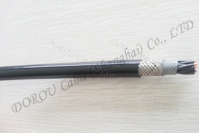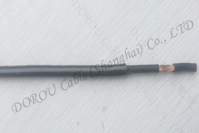Robotic Applications: Flexible or High-Flex Cables
When looking to install a robot or an end effector, cabling is one of the important items to think about. Some may think that any simple cable, such as a communication cable or a power cable, would do the job for whatever you need. However, there exists many different types of cables and not all of them are suitable for robotic applications.
In robotic applications, cable flexibility is important to consider, since the cable must follow the robot's movements. We hear a lot about flexible, continuous flex or high-flex cables, but what are their real characteristics and differences?
Flexible Cables
In fact, the majority of cables are flexible. The flexibility of a cable gives it the ability to bend in order to facilitate installation. It also allows it to follow one installation path easily. Moreover, their round design gives them greater reliability when it comes to bending, since they can bend in any directions. And Generally, a flexible cable is meant to stay static after its installation.
Continuous Flex or Flexing Cables
When it comes to constant movement and flexing, the cable required needs to have a tougher design to allow them to be exposed to constant flexing.
In order to design a continuous flex cable, there are certain features that are often incorporated into the cable. The cable jacket and inner conductor insulation should tend not to retain their deformation. The overall cable should have a loose construction in order to allow the conductors to freely move without damaging them. The right copper alloy is also an important feature, because some can handle more flexing than others. Finally, it is important to test and rate the flex-life.
Tests
Continuous flex cables are tested and rated to know their flex-life. Northwire developed two tests that have been standardized to prove the performance of any cable. This protocol is known as the Northwire Standardized Flex Test Protocol (NSFTP).
Flex-Life
It is important to choose the right cable for your application, because using a bending cable might not be the right choice for an operation where a lot of twisting is involved. So, when asking for the flex-life of your cable, it is important to ask, in which mode they were tested. The flex-life is define by the number of cycles it can withstand.
Information about
recommended product
Hot Sale
Top articles
- The current gap between the wire and cable industry
- Wire and cable market will reach $ 27 billion in 2015 in USA
- The status of the wire and cable industry
- Aluminum alloy will be the star of the wire and cable industry
- Robotic Applications: Flexible or High-Flex Cables
Latest articles
- What is the difference between German cable and domestic cable?
- Robotic Applications: Flexible or High-Flex Cables
- Application of Drag Chain Cable
- Why is your price more expensive than other domestic company's?
- Application of Reel Cable
- Application of Spreader Cable
- The current gap between the wire and cable industry
- Can the delivery of product be faster?
- Wire and cable market will reach $ 27 billion in 2015 in USA
- Can I have products delivered?














